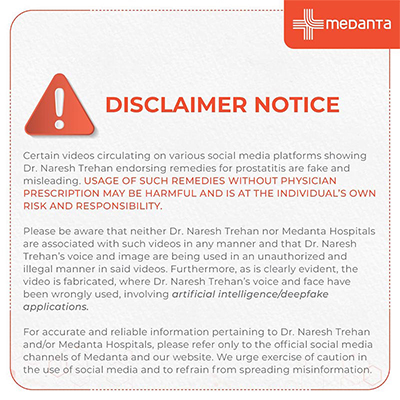Understanding Vision Loss Causes and Maintaining Healthy Eyes

TABLE OF CONTENTS
Have you ever wondered why some people lose their vision as they age while others maintain sharp eyesight well into their golden years? We often take the health of our eyes for granted until problems arise. Dr. Sudipto Pakrasi, a renowned ophthalmologist from Medanta, The Medicity, Gurugram, sheds light on the primary causes of vision loss and offers valuable tips for keeping our eyes healthy at every age.
The Top 5 Causes of Vision Loss
Understanding the common causes of vision loss is crucial for maintaining healthy eyesight. Dr. Pakrasi identifies five main culprits:
1. Cataracts: The Leading Cause of Treatable Vision Loss
Cataracts top the list as the most common cause of vision loss in the general population. The good news? It is also the most treatable. Dr. Pakrasi explains, “Cataract is the largest number of preventable blindness which we find, which is easily curable.” This condition happens when the eye’s natural lens becomes cloudy. It can lead to blurred vision and increased sensitivity to glare.
2. Age-related Macular Degeneration: A Growing Concern
As our population lives longer, age-related macular degeneration (AMD) is becoming increasingly prevalent. This condition affects the central part of the retina (macula - responsible for sharp, detailed vision). Dr. Pakrasi notes, “These are becoming much more prevalent because of the increasing longevity of the human population.”
3. Diabetic Retinopathy: A Lifestyle-related Threat
With the rise of diabetes worldwide, diabetic retinopathy has become a significant concern. This condition damages the retinal blood vessels, potentially leading to severe vision loss if left unchecked. Dr. Pakrasi warns, “These are extremely potentially blinding, and they can really devastate the quality of life for people if not controlled and detected and managed.”
4. Corneal Diseases: More Common in Rural Areas
While less prevalent in urban settings, corneal diseases pose a significant threat to vision, especially in rural populations. These conditions affect the eye's outer layer and can cause vision-related problems if not treated promptly.
5. Glaucoma: The Silent Thief of Sight
Dr. Pakrasi describes glaucoma as a “silent killer” and a “sneak thief” of vision. What makes glaucoma particularly dangerous is its lack of early symptoms. “There are no symptoms which can lead a person to understand that there’s a problem in the eye,” Dr. Pakrasi explains. Periodic eye tests are crucial for early detection & treatment of glaucoma.
Warning Signs: When to Seek Eye Care
While some eye conditions develop silently, there are warning signs you should never ignore. Dr Pakrasi advises being aware of the following symptoms:
A sudden drop in vision quality
Glare, halos, or starburst effects around lights
Fluctuations in vision clarity
Itching, irritation, pain, or redness in the eyes
Excessive tearing or dry eyes
Double vision (diplopia)
Drooping eyelids or squinting
If you experience any of these symptoms, seeking immediate attention from an eye care professional is essential.
Essential Eye Health Tips for Every Age
These eye health tips can significantly reduce your risk of developing vision problems. Dr. Pakrasi offers tailored advice for different age groups:
Children and Teenagers
Schedule eye exams every 2-3 years for children without vision problems
If a child wears glasses or shows signs of eye issues, increase exam frequency to every 6 months
Pay special attention during the teenage years, as growth spurts can affect vision
Adults (20-40 years)
Get an eye exam every 5 years if you have no vision problems
If you wear corrective lenses, maintain annual check-ups
Adults Over 40
Schedule yearly eye exams, regardless of your current vision status
Be vigilant about changes in your near vision, as this is when age-related conditions often begin to develop
Dr. Pakrasi emphasises, “It is recommended to get an examination done once a year after 40 years."
Taking Action for Lifelong Eye Health
Your eyes are invaluable assets that deserve the best care possible. Understanding the causes of vision loss and following age-appropriate eye care recommendations can significantly reduce your risk of developing severe eye conditions.
Remember, many eye problems develop without early warning signs. Regular eye exams can be your best defence against vision loss.
Conclusion
Your vision is one of your greatest assets—don't wait for problems to arise before taking care of it. From childhood to old age, prioritising eye health through regular check-ups and lifestyle choices can prevent many sight-threatening conditions. Awareness is key in protecting young eyes, managing age-related changes, or catching silent conditions like glaucoma early. By staying proactive, you're not just preserving your eyesight—you're ensuring a future where you continue to see life in all its vivid detail.
FAQs
What are some signs that I might be experiencing vision loss?
The following are some signs of vision loss:
Blurred or hazy vision
Difficulty seeing in low light
Increased sensitivity to glare
Frequent changes in prescription glasses
Seeing floaters or flashes of light
Trouble reading or recognising faces
Double vision or tunnel vision
When should I seek medical advice?
A sudden drop in vision quality
Glare, halos, or starburst effects around lights
Fluctuations in vision clarity
Itching, irritation, pain, or redness in the eyes
Excessive tearing or dry eyes
Double vision (diplopia)
Drooping eyelids or squinting
How can I prevent vision loss?
Maintain a healthy diet enriched in vitamins A, C, and E
Wear UV-protective sunglasses outdoors
Control conditions like diabetes and high blood pressure
Avoid smoking and excessive screen time
Get regular eye exams for early detection
This blog has been converted from the Youtube video- Vision loss causes and secret of good eyesight at every age | Dr Sudipto Pakrasi | Medanta Gurugram






